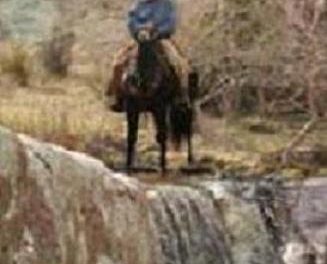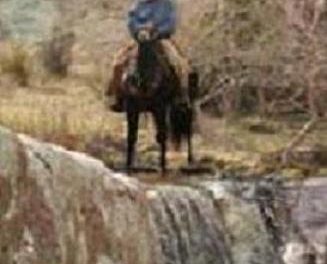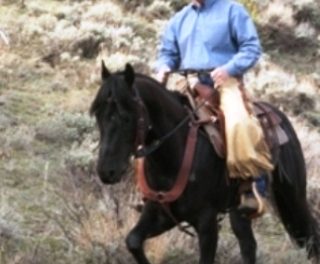 Teaching tricks can be a fun way to work with your horse. It changes things up a bit and makes it interesting and exciting for both of you. We’re going to cover teaching two tricks here: first, teaching your horse to side pass towards you, and second, teaching your horse to shake his head yes and no. For these exercises, you will need your horse bridled with a snaffle bit and loop rope reins, a short dressage type whip, and a ball point pen with a retractable point.
Teaching tricks can be a fun way to work with your horse. It changes things up a bit and makes it interesting and exciting for both of you. We’re going to cover teaching two tricks here: first, teaching your horse to side pass towards you, and second, teaching your horse to shake his head yes and no. For these exercises, you will need your horse bridled with a snaffle bit and loop rope reins, a short dressage type whip, and a ball point pen with a retractable point.
As with all the exercises you teach, your goal as a trainer should be to make things as simple as possible for your horse to understand. Break things down into small pieces, and remember to reward your horse regularly. Start by setting a very clear end goal for the exercise, and every time your horse gives you a response, ask yourself: did your horse get closer to the stated goal? The answer should be a simple yes or no. If it’s yes, release and reward. If the answer is no, keep asking until you get a response that does bring you closer to your goal.
If your horse has just come out of a stall or hasn’t been worked in a while and seems fresh and full of energy, take a minute to work on an exercise that allows him to move his feet. This is an important principle. If your horse has lots of energy and you are determined to start with an exercise that requires him to stand, you are likely to have trouble. Start working where both you and your horse can win.
When you are ready, start the sidepass exercise. You will need your horse bridled, and the short whip in your hand. Take your horse to an arena or pen where you have a wall you can work along. Lead him up until he is parallel with the wall. Take the inside rein in your hand closest to him, and hold the whip in your other hand. Your goal is for him to move his hip out away from the wall towards you. Think about an imaginary line that passes about 2” to the inside of his hip. Every time he moves his hip through that line, he’s going in the right direction. The reason you start this exercise along a wall is to make it easier for your horse to get the right answer. You are blocking him from moving away from you with the wall, blocking forward motion with the bridle, and blocking backward movement with the whip. This leaves him with the opening of moving out away from the wall towards you, which is exactly what you want.
Hold your hand up in the air to start, without extending the whip. This is your cue. Of course at first he won’t know what you want. If you don’t get a response, use the whip to lightly tap the point of his hip in rhythms of three until he moves even the slightest bit out towards you. Use the wall, your bridle, and the whip tapping to control his movement if he tries to go forward, back, or away from you. Don’t get worried or excited if he doesn’t do what you want, just keep giving the cue calmly and consistently until you get the response you wanted. Then stop tapping, pet him on the shoulder, and tell him he’s done well. Build on these steps, gradually getting your horse to step farther and farther out from the wall towards you until he is facing directly in to the wall with his body at a ninety degree angle from where you started. Then, you are ready to start asking him to step over towards you with both the hips and shoulders. Once he is sidepassing down the wall towards you, he challenge by moving farther away from the wall gradually. There are two important things I want to mention here. One is that when you are teaching your horse a cue to move in to you, it’s important that you also teach a cue to move away from you. I like to have the raised hand the clear cue to move towards me, and have a cue spot lower on the ribcage to move away. The other thing is that it’s important to have an end cue for the behavior. An end cue is just as important as the cue that initiates a behavior, and it clearly signals for your horse the end of the exercise. I like to end the sidepass cue with a pat on the shoulder. So from the beginning, I reward my horse with a pat on his shoulder, and later in the exercise, that becomes my cue to end the behavior.
To teach your horse to shake his head yes and no, you won’t need your whip any more but you will need to get out your ballpoint pen. For the yes head shake (up and down) I use a cue point on the front of the shoulder. For the no head shake (side to side) I use a cue spot in the middle of the neck. Make sure to put your cue spots in a place where they will not interfere with another common cue, and also where you won’t inadvertently give the cue all the time (like on the withers where a saddle pad might rub or bump your horse while you are riding).
Tap your pen on the point of your horse’s shoulder. At first, you are just looking for any movement of his head. As soon as you get this, stop tapping him with the pen and pet him. If you get no response from tapping with the blunt end of the pen, you can extend the writing tip. Just be sure to retract it before you start to give the cue again. Once you are getting head movement on a regular basis, only reward if your horse shakes his head up and down for yes.
Then, repeat the same process to teach your horse to shake his head side to side for no, using the cue spot on his neck.
These are just a few of the many tricks you can teach your horse. Through any exercise you teach, remember to keep it simple, stay calm and consistent, and reward your horse every time he gets closer to the goal.
Enjoy your horses, and until next time, may God bless the trails you ride.
For more information on Ken McNabb’s programs call us at 307-645-3149 or go to www.kenmcnabb.com.





